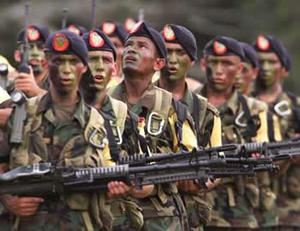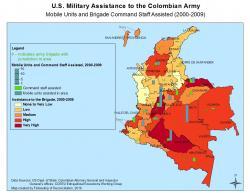
Last Friday President Barack Obama ordered the deployment of 100 armed military advisers to central Africa to help regional forces fight the Lord’s Resistance Army, a Ugandan guerrilla group. This new intervention sheds some light into the spectrum of U.S. military involvement in a number of armed conflicts worldwide, which are ranging from open large-scale wars, such as Iraq and Afghanistan, to smaller wars such as the ones in Pakistan, Yemen, and now central Africa. Among the wide spectrum of U.S. international conflicts is the U.S. war in Colombia. This war has been often understated and almost forgotten, but thanks to recently-released documents the U.S. involvement in Colombia is increasingly coming to light.
Since the U.S.-sponsored Plan Colombia was introduced in 2000, the U.S. war in Colombia has intensified, altering the incentives for the battling factions, and changing the dynamics of the conflict. The Colombian state and the dominant classes—particularly the most reactionary cattle ranchers, large landowners, some agribusinesses, and their political allies—believed that the U.S. military assistance would allow them to win the war and thus had less of an incentive to negotiate a peaceful settlement.
Now eleven years later, the U.S. has wasted more than $7 billion-mostly in military aid-, and supported the Colombian government with trainers, special operation forces, private contractors, and intelligence services. Yet the conflict continues unabated. There are no accurate estimates of the number of U.S. personnel and services deployed in the Colombian war. The little that is known, however, is filtering out, slowly painting us a picture of this secret U.S. war—longer than either Iraq and Afghanistan, and much more important that the latest central Africa adventure.
Excerpts from two recently-released WikiLeaks documents help to highlight the magnitude and scope of the U.S. involvement.
 The first cable was written in 2006 by then U.S. Ambassador to Colombia, William B. Wood. (GOC is an abbreviation for the Colombian government and USG is the abbreviation for the U.S. government.) The cable summary reads:
The first cable was written in 2006 by then U.S. Ambassador to Colombia, William B. Wood. (GOC is an abbreviation for the Colombian government and USG is the abbreviation for the U.S. government.) The cable summary reads:
The GOC captured or killed 29 key midlevel operatives of the country's main guerilla insurgencies, the Revolutionary Armed Forces of Colombia (FARC) and the National Liberation Army (ELN), from September 2005 through April 2006. Takedowns were concentrated among three groups -- front commanders, finance officers, and explosives experts -- who are vital to guerilla activities and difficult to replace. The operations were guided by intelligence packages assembled with heavy USG support. Continued cooperation between USG and GOC intelligence units aims to chip away at the guerillas' middle management, as one element in a concerted set of strategies to weaken these organizations over time.
The cable continues and uncovers the level of cooperation between the Colombian and U.S. governments.
The USG has worked closely with GOC intelligence units in capacity building, and the two sides continue to cooperate in planning specific operations. Of the 29 cases discussed above, about 30% were carried out by the GOC independently, while 70% were conducted with USG assistance. Typically GOC entities in the field collect raw data, filtered and prioritized by the USG into operational packages, which the GOC in turn executes. This cooperation has yielded a quantum increase in the volume of actions undertaken, as well as higher-quality vetting of prospective actions and tighter operational planning. The main drawback is a perceived GOC dependency on U.S. support, no longer in terms of skills but rather in motivational drive and sense of urgency, which still derives from U.S. pushing. The appointment of Camilo Ospina as Minister of Defense earlier this year has been a positive development in this regard: he is a strong supporter of intelligence work and a catalyst for increasing the volume of intel-guided activity.
An earlier cable, from November 20, 2003, also shows the direct U.S. participation in the war. (NAS refers to the Narcotics Affairs Section of the U.S. embassy in Colombia.)
In 2003 On November 20, NAS supported a Counter-narcotics Brigade mission in Meta Department in a successful combined-arms operation involving ground troops, intelligence, transport, and strike aircraft operating in concert. Four UH-60 Plan Colombia helicopters, escorted by four UH-1N Plan Colombia aircraft, transported the assault force to the target area. The UH-1N escorts destroyed two trucks transporting enemy reinforcements, resulting in an unknown number of enemy casualties. The Colombian Air Force supported the mission with preplanned fire from fixed-wing and helicopter gun ships. Ground forces seized or destroyed the following assets: estimated 16,000 gallons of liquid chemical precursors; 2.2 MT of solid precursors; three MT of ANFO explosives; 79 explosive cylinders of varying sizes (20, 40, and 100 pounds); 21 mortars; four trucks; three motorcycles; 40 mines; 500 meters of detonation cord; and 50 car alarms used in remote detonators. Four personnel were also captured. This successful action will serve as a model for future operations.
 These two cables provide a glimpse of the ongoing U.S. war in Colombia that is largely outflanked by Afghanistan and Iraq, but of no less importance. Millions of Colombians are waiting for a peaceful resolution that will not come without a significant change in U.S. policy.
These two cables provide a glimpse of the ongoing U.S. war in Colombia that is largely outflanked by Afghanistan and Iraq, but of no less importance. Millions of Colombians are waiting for a peaceful resolution that will not come without a significant change in U.S. policy.
For more from Nazih Richani's blog, Colombian Cuadernos, visit nacla.org/blog/cuadernos-colombianos, or see the NACLA Report July/August 2009, "Coercion Incorporated: Paramilitary Colombia."

